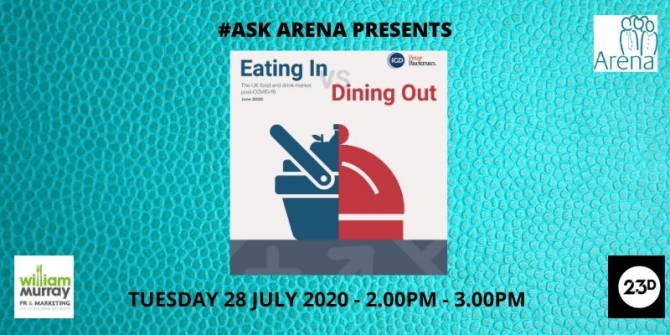
Eating In vs Dining Out
Presented by Rhian Thomas & Nicola Knight, IGD
For this exclusive #AskArena event, in partnership with William PR & Marketing and 23 Digital video agency, we were delighted to welcome Nicola Knight, Senior Food-to-Go Analyst and Rhian Thomas, Head of Shopper Insight from the IGD who shared some fascinating shopper insight and key findings from their latest report Eating in vs Dining Out. Written in collaboration with hospitality and restaurant consultant, Peter Backman, the report gives four possible outcomes from the pandemic, enabling operators, suppliers and retailers to scope and plan for the future.
Join the conversation #AskArena






Event Review
Planning for the future in uncertain times
For our latest #AskArena event, in partnership with William PR & Marketing and 23 Digital video agency, we were delighted to welcome Nicola Knight, Senior Food-to-Go Analyst and Rhian Thomas, Head of Shopper Insight from the IGD who shared some fascinating shopper insight and key findings from their latest report Eating in vs Dining Out. Written in collaboration with hospitality and restaurant consultant, Peter Backman, the report gives four possible outcomes from the pandemic, enabling operators, suppliers and retailers to scope and plan for the future.
The webinar began with an overview of the food and drink landscape, which also acts as the baseline for the report.
In 2019, consumers spent almost £200bn on food and drink, 36% was in foodservice. Both big and small retailers were buying in foodservice expertise and we were beginning to see grocery and ‘eating out’ under one roof through brands like Jumbo Food Market in Holland and Freshly Chopped in Dublin – a made to order fresh salad concept within Spar stores. Technology was growing, so were food halls and new concepts were coming through such as Wagamama’s little sister Mamago and McDonald’s first takeaway only store. Plant-based foods were high on the agenda as was sustainability and ‘farm to table’ concepts such as Farmer J in the UK.
Boundaries between eating in and eating out had already begun to blur over the last few years, but the pandemic has without a doubt accelerated the blurring further. Branded meal kits and ‘at home’ offers from branded restaurants, such as Cote, are a prime example.
So, what could the post-covid world have in store?
The four scenarios from the Eating In vs Dining Out report:
A The Great Reset
The most positive outcome from the pandemic. This assumes that there will be a vaccine and herd immunity will be realised. As a consequence, consumption will shift initially in-home and there will be knock-on effects to the supply chain. Some businesses will fail, but new ones will fill the gap. It’s the ‘v’ shaped recovery, that everyone is hoping for – eating out will return to 2019 levels in two years.
B Decade of Drift
This presumes that the virus recovery will be similar to scenario A, but the economic impact will have a dramatic effect. There will be cost-cutting and efficiency programmes, lower levels of NPD and premium products will be hit. Consumers will want to eat out but many won’t be able to afford to. Demonstrating value will be vital. The path to recovery will be U-shaped and long term.
C Technical Isolation
This scenario is based around no effective solution to coronavirus and the country potentially having to lockdown again. Foodservice businesses would be badly hit and sites that can’t be repurposed to increase online or delivery will close. However, it could be a potentially exciting period for food entrepreneurs and technical innovators.
D Globalisation Reversed
This is the most severe scenario – the emphasis is on operational efficiency and doing ‘more with less’. There will be extreme pressure on the supply chain and delivery and takeaway is almost the only foodservice option.
To find out more about Eating In vs Dining Out and the IGD, please contact: Rhian Thomas: Rhian.Thomas@igd.com / 07980 677322 or Nicola Knight: Nicola.Knight@igd.com / 07739 707754
If you wish to register to receive the IGD’s free newsletter, click here.

